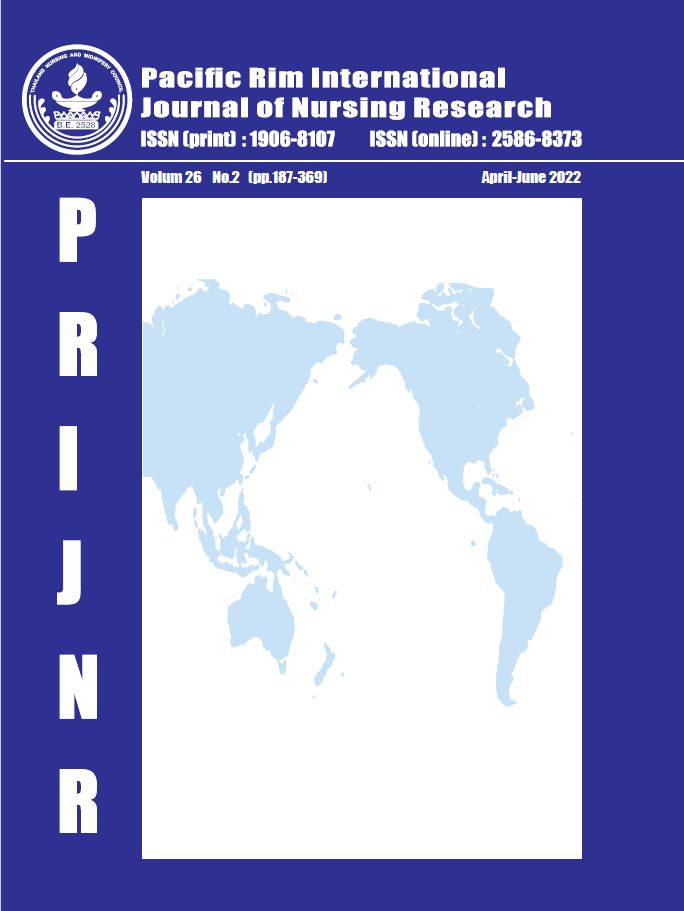Preconception Care for Having a Male Descendant: An Ethnographic Study of Indonesian Batak Women
Keywords:
Indonesian Women, Ethnography, Knowledge, Perception, Preconception Care, Stress, Unplanned PregnancyAbstract
Indonesia is still facing high maternal and infant mortalities cases, and preconception care is one of the essential interventions to prepare for a healthy pregnancy and try to avoid these cases. This ethnographic study explores how Indonesian Batak women deal with preconception care and how they perceive cultural influence in their pregnancy preparation. Semi-structured interviews with 14 Indonesian Batak women and field observations were conducted in this study. The informants were recruited purposively under specific criteria. Recorded and transcribed data were analyzed thematically.
Four themes were constructed from the data: perceptions and knowledge of preconception care, rituals, family pressure to have a son, and stressful unplanned pregnancy. Batak women have some knowledge about preconception care, and families conduct cultural rituals for these women in the hope that they give birth to a son. However, when a baby boy is not coming to the family, the women suffer from stressful unplanned pregnancies. The findings show that the Batak culture supports preconception care; however, the family often has less tolerance to women’s reproductive health rights in preserving the paternal line. Health care providers, including nurses and midwives, should educate and empower the women for preconception care and contraceptive use and culturally negotiate with the family to optimally support the women’s health.
References
Kementerian Kesehatan RI. Indonesian health profile in 2020. Kementrian Kesehatan RI, Jakarta. 2021. Available from: https://pusdatin.kemkes.go.id/folder/view/01/structure-publikasi-pusdatin-profil-kesehatan.html (in Indonesian)
Hemsing N, Greaves L, Poole N. Preconception health care interventions: a scoping review. Sex Reprod Healthc. 2017;14:24-32. https://doi.org/10.1016/j.srhc.2017.08.004
Stephenson J, Heslehurst N, Hall J, Schoenaker DAJM, Hutchinson J, Cade JE, et al. Before the beginning: nutrition and lifestyle in the preconception period and its importance for future health. Lancet. 2018;391:1830- 41. https://doi.org/10.1016/S01 40-6736(18)30311-8
Lassi ZS, Dean SV, Mallick D, Bhutta ZA. Preconception care: delivery strategies and packages for care. Reprod Health. 2014;11 Suppl 3(Suppl 3):S7. https://doi.org/10.1186/1742-4755-11-S3-S7
World Health Organization. Preconception care: maximizing the gains for maternal and child health. Department of Maternal, Newborn, Child, and Adolescent Health, Geneva. 2013. Available from: https://www.who.int/maternal_child_adolescent/documents/preconception_care_policy_brief.pdf
National Population and Family Planning Board (BKKBN), Statistics Indonesia (BPS), Ministry of Health (Kemenkes), and ICF. Indonesia demographic health survey 2017. BKKBN, BPS, Kemenkes, and ICF, Jakarta. 2018. Available from: https://dhsprogram.com/pubs/pdf/
FR342/FR342.pdf
Tuomainen H, Cross-Bardell L, Bhoday M, Qureshi N, Kai J. Opportunities and challenges for enhancing preconception health in primary care: qualitative study with women from ethnically diverse communities. BMJ Open. 2013;3:e002977. http://dx.doi.org/10.1136/bmjopen- 2013-002977
Toivonen KI, Oinonen KA, Duchene KM. Preconception health behaviours: a scoping review. Preventive Medicine. 2017;96:1-15. https://doi.org/10.1016/j.ypmed.2016. 11.022
Kufakunesu L, Shumba P, Kapfunde A, Zvinavashe PM, Makoni DP. Preconception care: concept paper. Journal of Health Sciences and Nursing. 2017;2(11), 42-53. https://www.ijrdo.org/index.php/hsn/article/view/1157
Yulizawati Y, Nurdiyan A, Iryani D, Insani AA. Effect of health education using peer education method on preconception screening on the knowledge and attitudes of women of childbearing age in Agam. Journal of Midwifery Research and Practice. 2016;1(2);11-20. doi:10.25077/
jom.1.2.11-20.2016 (in Indonesian).
Juriah. Cultural beliefs and practices during pregnancy of the Karangsari Village community, Garut Distrik. Sosiohumaniora Jurnal Ilmu-ilmu Sosial dan Humaniora. 2018;20(2):162-7. https://doi.org/10.24198/sosiohumaniora.v20i2.10668 (in Indonesian).
Kurniawati W, Afiyanti Y, Prasetyo S, Achadi EL, Kumboyono K. The perspective of healthcare practitioners on preconception care at primary healthcare in Jakarta:a qualitative study. International Journal of Africa Nursing Sciences. 2021;15:100351. https://doi.org/10.1016/
j.ijans.2021.100351
Hasibuan R. Married in Batak culture. 2015. Available from: https://www.kompasiana.com/rickyhasibuan/55007a78a333117f7251117a/perkawinan-menurutadat-batak (in Indonesian)
Sibarani R, Situmorang H, Pawiro MA. Concerning Toba Batak’s local wisdoms and cultural values for regional character building. Indian Journal of Science and Technology. 2018:11(20):1-9. doi:10.17485/ijst/2018/v11i20/114298.
Creswell JW. Research design: qualitative, quantitative, and mixed methods approaches. SAGE Publications, Los Angeles. 2014.
Kottak CP. Cultural anthropology: appreciating cultural diversity Ed. 16th. New York: McGraw Hill. 2015
Field T. Massage therapy research review. Complement Therapy Clinical Practice. 2014;20(4):224-9. https://doi.org/10.1016/j.ctcp.2014.07.002
Gunawan. Mangukosi dan Upa-upa, meaningful Batak tradition. 2015. Available from: https://www.kompasiana.com/gun4w4n/551feec5a33311e32bb67358/mangulosidan-upa-upa-tradisi-adat-batak-penuh-makna (In Indonesian)
Alligood MR. Nursing theorists and their work. 8th ed. Elsevier, Singapore. 2017 (in Bahasa Indonesian).
McFarland MR, Mixer SJ, Webhe-Alamah H. Ethnonursing: a qualitative research method for studying culturally competent care across disciplines. Int J Qual.2012;11(3):259-79. https://doi.org/10.1177/160940691201100306
Afiyanti Y, Rachmawati IN. Qualitative methodology in nursing research. Rajawali Pers, Jakarta. 2014.
Simbolon CJ, Siregar RH. The value of Hagabeon and the efforts to get offspring in Infertile Toba Batak Tribe couples. Psikologia. 2014;9(1);25-31. https://jurnal.ugm.ac.id/buletinpsikologi/article/view/28489 (in Indonesian).
Girsang IE. The ceremony of manonggot-nonggoti practiced by Simalungun Society. 2015. Available from:https://search.yahoo.com/search?fr=mcafee&type=E210US91215G91418&p=The+Ceremony+of+Manonggot-nonggoti+Practiced+by+Simalungun+Society+Retrieved+from+http%3A%2F%2Frepository.usu.ac.id%2Fhandle%2F123456789%2F54151
Lang AY, Boyle JA, Fitzgerald GL, Teede H, Mazza D, Moran LJ. Harrison C. Optimizing preconception health in woman of reproductive age. Minerva Gynecologica. 2018;70(1):99-119. doi:10.23736/S0026-4784.17.04140-5.
Qureshi R, Pacquiao DF. Ethnographic study of experiences of pakistani women immigrants with pregnancy, birthing, and postpartum care in the United States and Pakistan. Journal of Transcultural Nursing. 2013;24(4):355-62. https://doi.org/10.1177/1043659613493438
Sitohang A. Batak philosophy in the life aim. 2018. Available from: https://hitabatak.com/filsafat-batak-dalamtujuan-hidup-3h-kesuksesan-bangso-batak/ (in BahasaIndonesian)
Novieastari E, Gunawijaya J, Indracahyani A. Culturally sensitive nursing care training effectively improves nurse’s cultural competence. Keperawatan Indonesia. 21(1):27-33. doi:10.7454/jki.v21i1.484 (in Indonesian).
Simamora H, Siti A. Anxiety levels differences between indigenous and migrant Batak fathers who don’t have boys. Anthropos: Jurnal Antropologi Sosial dan Budaya. 2018;3(2):117-121. https://doi.org/ 10.24114/antro. v3i2.8307 (in Indonesian).
Downloads
Published
How to Cite
Issue
Section
License
Copyright (c) 2022 Pacific Rim International Journal of Nursing Research

This work is licensed under a Creative Commons Attribution-NonCommercial-NoDerivatives 4.0 International License.
Copyright: The Pacific Rim International Journal of Nursing Research, Thailand Nursing & Midwifery Council has exclusive rights to publish, reproduce and distribute the manuscript and all contents therein.








.png)



